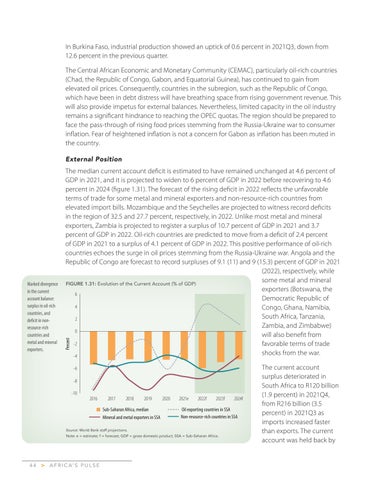In Burkina Faso, industrial production showed an uptick of 0.6 percent in 2021Q3, down from 12.6 percent in the previous quarter. The Central African Economic and Monetary Community (CEMAC), particularly oil-rich countries (Chad, the Republic of Congo, Gabon, and Equatorial Guinea), has continued to gain from elevated oil prices. Consequently, countries in the subregion, such as the Republic of Congo, which have been in debt distress will have breathing space from rising government revenue. This will also provide impetus for external balances. Nevertheless, limited capacity in the oil industry remains a significant hindrance to reaching the OPEC quotas. The region should be prepared to face the pass-through of rising food prices stemming from the Russia-Ukraine war to consumer inflation. Fear of heightened inflation is not a concern for Gabon as inflation has been muted in the country. External Position
Percent
Marked divergence in the current account balance: surplus in oil-rich countries, and deficit in nonresource-rich countries and metal and mineral exporters.
The median current account deficit is estimated to have remained unchanged at 4.6 percent of GDP in 2021, and it is projected to widen to 6 percent of GDP in 2022 before recovering to 4.6 percent in 2024 (figure 1.31). The forecast of the rising deficit in 2022 reflects the unfavorable terms of trade for some metal and mineral exporters and non-resource-rich countries from elevated import bills. Mozambique and the Seychelles are projected to witness record deficits in the region of 32.5 and 27.7 percent, respectively, in 2022. Unlike most metal and mineral exporters, Zambia is projected to register a surplus of 10.7 percent of GDP in 2021 and 3.7 percent of GDP in 2022. Oil-rich countries are predicted to move from a deficit of 2.4 percent of GDP in 2021 to a surplus of 4.1 percent of GDP in 2022. This positive performance of oil-rich countries echoes the surge in oil prices stemming from the Russia-Ukraine war. Angola and the Republic of Congo are forecast to record surpluses of 9.1 (11) and 9 (15.3) percent of GDP in 2021 (2022), respectively, while some metal and mineral FIGURE 1.31: Evolution of the Current Account (% of GDP) exporters (Botswana, the 6 Democratic Republic of 4 Congo, Ghana, Namibia, South Africa, Tanzania, 2 Zambia, and Zimbabwe) 0 will also benefit from -2 favorable terms of trade shocks from the war. -4 -6 -8 -10
2016
2017
2018
2019
Sub-Saharan Africa, median Mineral and metal exporters in SSA
2020
2021e
2022f
2023f
Oil exporting countries in SSA Non-resource-rich countries in SSA
Source: World Bank staff projections. Note: e = estimate; f = forecast; GDP = gross domestic product; SSA = Sub-Saharan Africa.
44
>
A F R I C A’ S P U L S E
2024f
The current account surplus deteriorated in South Africa to R120 billion (1.9 percent) in 2021Q4, from R216 billion (3.5 percent) in 2021Q3 as imports increased faster than exports. The current account was held back by

